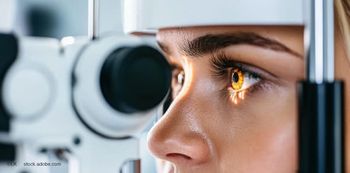
Q&A: Robert H. Osher, MD, on how VR is changing the cataract conversation
By letting patients “see” their options before surgery, virtual reality may eliminate confusion, boost confidence, and strengthen surgeon–patient trust.
Navigating intraocular lens (IOL) options can be overwhelming for patients with cataract, who often find it difficult to distinguish among monofocal, multifocal, and premium lenses.1,2 A newly launched IOL simulation technology platform (Immersive IOL Simulator; VirtuaLens) uses virtual reality (VR) to give patients a realistic, 3D preview of how each lens will perform in everyday life1,2
RELATED: VirtuaLens introduces immersive VR IOL simulation platform; partners with Virtual Vision Health
In this interview with the Eye Care Network, Robert H. Osher, MD, shares why VR technology could be the next leap in helping patients select the IOL most appropriate for their visual needs and lifestyle. Osher is professor of ophthalmology, University of Cincinnati College of Medicine; medical director emeritus, Cincinnati Eye Institute in Ohio; and founder and editor, Video Journal of Cataract, Refractive, and Glaucoma Surgery.
Note: Transcript has been edited for clarity and length.
What makes this VR IOL simulation technology different from traditional methods of educating patients about IOL options?
Robert H. Osher, MD: The traditional approach to patient education about IOL choices has been the responsibility of the counselor, the physician, or both. There is also an abundance of pamphlets that help, and I have depended upon an explanatory video for decades. Although I am willing to invest time with every patient, the explanation of the choices is very difficult for the patient to understand.
By the time I have explained astigmatism for toric candidates, the advantages and disadvantages of multifocals, monovision, aniseikonia, and answered [numerous] questions, the patient may be more confused than ever and I’m exhausted. After the patient has finally made up his or her mind, many will ask if I think they’re making the right choice.
Q&A: Redefining cataract education for patients with virtual reality
Eliminating indecisiveness and the fear of buyer’s remorse remains an unmet need which is addressed by this system. For the first time, the patient can put on a VR headset and experience a preview of what each lens offers in multiple real-life settings.
In your experience, what are the biggest challenges patients face when trying to understand the differences between monofocal, multifocal, and premium lenses — and how does VR address those challenges?
Osher: The ophthalmologist has a background in optics, and we deal with these complex IOL designs every day. Yet even the most intelligent patients have difficulty understanding … the ophthalmic terms that we introduce when explaining and answering questions. The expression “a picture is worth a thousand words” applies as the patient enjoys a stunning preview of what can be expected for each lens option. Multiple scenes including a mountain view, kitchen, bedroom, golf, and driving clearly demonstrate the advantages and disadvantages of the different IOLs.
How do you see this technology impacting the relationship between surgeons and patients, particularly in terms of trust and shared decision making?
Osher: As soon as the patient removes the VR headset, he or she will have a much better understanding of what each IOL offers. Although the technology is in its infancy, the plan is to allow each surgeon to customize the narration. The patient will be “communicating” with the physician, even though the surgeon may not be physically present. I believe the questions that the patient will ask will be more sophisticated and less numerous, allowing the surgeon to answer in a way that continues to build a trusting relationship. When a patient has more confidence about selecting the best lens for his or her needs, it is likely that this confidence will add value to the patient-physician relationship.
Cataract surgery is one of the most common procedures worldwide. Do you believe immersive VR education could become a standard of care in the future, and what steps would it take to get there?
Osher: I was absolutely certain in the early 1980s that video would eventually prevail, and I delivered the Heritage Lecture in Copenhagen reviewing this remarkable journey.3 I also believed that 3D would become a standard in medical education. VR is a superior technology for educating patients so I am confident that it will be widely embraced. Declining reimbursement may delay the acceptance of any new technology, but like phaco, implants, and refractive cataract surgery, ophthalmologists will try VR, which will elevate patient education in the future.
From a surgeon’s perspective, how might the VR IOL simulator affect clinical efficiency—for example, reducing chair time or improving patient satisfaction scores?
Osher: It is a certainty that [this ] will reduce chair time. Once the patient has enjoyed a preview of what different IOLs offer in a variety of settings, I expect that most patients will be able to decide with confidence which IOL they prefer. Questions to the surgeon will be more knowledgeable and fewer in number. I believe that this technology will improve the surgeon’s efficiency,
Robert H. Osher, MD
E: [email protected]
Osher is professor of ophthalmology, University of Cincinnati College of Medicine; medical director emeritus, Cincinnati Eye Institute in Ohio; and founder and editor, Video Journal of Cataract, Refractive, and Glaucoma Surgery. Osher is a consultant with VirtuaLens.
REFERENCES
- VirtuaLens launches immersive virtual reality IOL simulator, transforming cataract patient education and lens selection. News release. September 3, 2025. Accessed September 9, 2025.
https://virtualens.health/virtualens-launches-immersive-virtual-reality-iol-simulator-transforming-cataract-patient-education-and-lens-selection/ - Virtual Vision Health and VirtuaLens forge strategic partnership to expand access to diagnostic eye care and patient education tools. News release. September 9, 2025. Accessed September 9, 2025.
https://virtualens.health/strategic-partnership-with-virtual-vision-health/ - Osher RH. Heritage Lecture: Video–couldn’t live without it! Presented at: 43rd Congress of the European Society of Cataract and Refractive Surgeons; September 12-16, 2025; Copenhagen, Denmark.
Newsletter
Don’t miss out—get Ophthalmology Times updates on the latest clinical advancements and expert interviews, straight to your inbox.













































.png)


